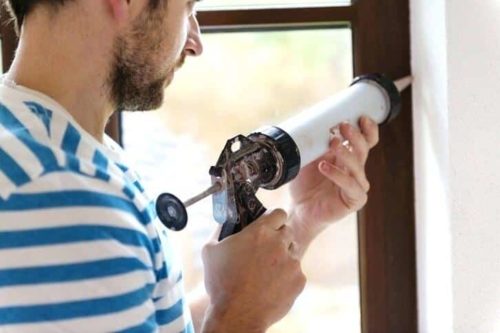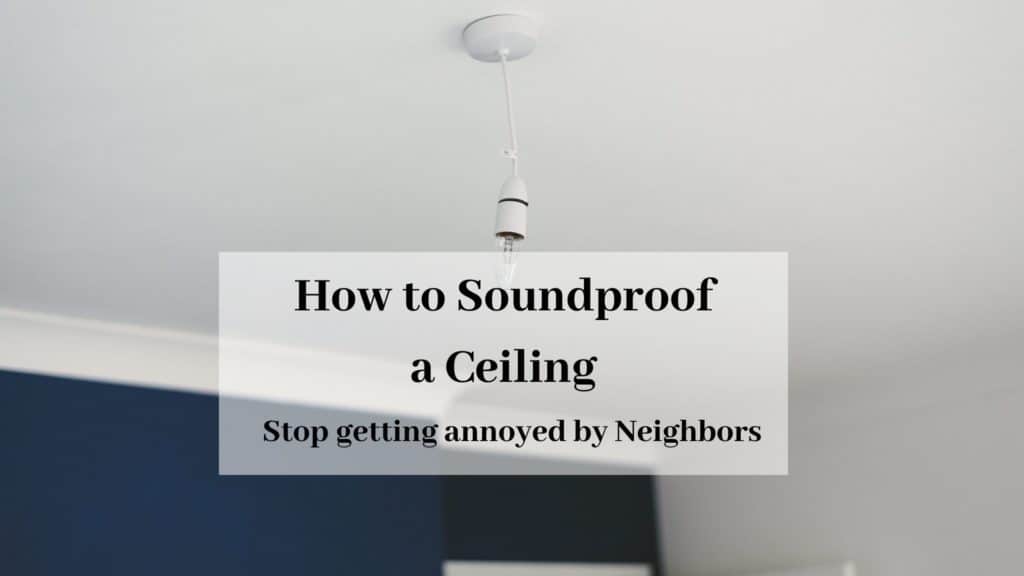If you live in one of those modern and good-looking apartments, then you probably noticed one thing…
The walls and the ceiling are extremely thin, in some cases it’s like they weren’t even there to begin with.
You can hear your upstairs neighbors’ footsteps, you can hear them argue, and in some cases, you can even understand what they are saying even if they are having a normal conversation.
This shouldn’t happen, but unfortunately, it does.
If the insulation wasn’t installed properly when the building was constructed, then fixing it afterwards might be a bit tricky, but it can be done.
In this article I will go over all of the options at your disposal, all the materials you can use and how to install them to properly reduce the noise that’s coming in through the ceiling.
Table of Contents
Table of contents
- Soundproofing Vs Acoustic Treatment
- Different Types of Noises
- Install Drywall on the Ceiling
- Install Mass Loaded Vinyl on the Ceiling
- Install Mass Loaded Vinyl with the Drywall
- Install BA Series 9 Panels
- Install Acoustic Foam Panels
- Use Glue Spray to adhere the panels
- Soundproof the Floor Above
- Conclusion
Things to take into Consideration
Before we get started, I think that it’s important to explain a couple things which should help you understand exactly what needs to be done and what methods work and which don’t;
Soundproofing Vs Acoustic Treatment
Some materials are good for soundproofing while some others are good for sound treating purposes.
What tends to happen is that you buy something like acoustic foam panels thinking that they will block sound, when in reality, acoustic foam panels only absorb sound.
They might reduce the amount of noise since they add an extra barrier, but it’s just a slight reduction.
You can learn more about the differences between soundproofing and acoustic treatment here.
Soundproofing
Soundproofing consists in utilizing materials which block sound not allowing it to get in or out of the room you’re in.
Example: If you live on a busy street and you want to lower the car noises coming in to your apartment, then you would need to soundproof the apartment.
Acoustic Treatment
Acoustic Treatment, on the other hand, consists of managing the sound generated INSIDE of the room by absorbing the soundwaves as best as possible, not allowing them to bounce all over the place.
This is essential for a music studio, for example, since you don’t want the microphones to pick up any of the ambient noise.
Different Types of Noises
There are two types of sound that you should know about;
Air-Borne Noise: These are the sounds generated in the air which then hit the walls, ceiling, etc. and generate vibrations which then travel through these structures.
If there are and gaps or cracks between the walls, doors, windows, etc. this kind of sound will have a very easy time getting in or out.
To get rid of Air-Borne Noise you mainly need to stop it from leaking out, which means sealing every gap and crack you can find.
Examples of air-borne noises are; TV, people talking, music playing, the noise tools make, etc.
Structure-Borne Noise: These types of sounds are created when an object hits another one and the vibrations generated travel through said objects like walls, ceilings, floors, etc.
Examples of structure-borne noise are; Footsteps, objects hitting the floor, machinery that vibrates against the floor or against a work table, etc.
To reduce Structure-Borne Noise you need to block the path and absorb the noise by installing materials, like Mass Loaded Vinyl, which do this.
Note: Installing materials like Mass Loaded Vinyl will also protect you from air-borne noise if this type of noise is being transmitted through the ceiling.
Take notice of Flanking Noise

Flanking noises are the ones which get transmitted through an indirect path.
In this particular case, the vibrations generated above can be transmitted from the ceiling to the walls and, in turn, into your apartment below.
The solution here is to also install some soundproofing materials on the walls.
There are many other pathways noise can use to find ways into your apartment, like vents, etc.
You should carefully listen where the noise is coming in, apart from the ceiling, and treat it.
Why is all this information important?
In order to make the right decision you first need to know what type of noise you’re dealing with and what materials should be used.
Otherwise you would probably buy some acoustic foam and glue it on to the ceiling, and while this might lower the noise a bit, it’s definitely not the best option.
Let’s get straight into it with the first option which is;
Install Drywall on the Ceiling

Installing an extra thick layer of drywall on ceiling is a great way to lower the amount of sound that is allowed through for the simple fact that you’re adding an extra layer of dense material.
Simply adding another layer will stop the vibrations and the sound transmitted by quite a bit.
The great thing about this method is that you can do it yourself and save a lot of the money that you would have otherwise spent on hiring a professional.
It will just take a bit of time, patience and some handiwork.
There are a couple of things to take into consideration;
Apply a Noiseproofing Compound
Before installing the Drywall make sure to apply a generous amount of this Green Glue Noiseproofing Compound (link to Amazon) behind the drywall sheets.
You don’t need to worry about the pattern or how you apply it, simply make sure that it’s evenly distributed.
This Noiseproofing Compound will further reduce noise transmission by a lot, so don’t skip it!
Apply Acoustic Caulk

Once the drywall sheets are in place, it’s time to seal the gaps left between those sheets with acoustic caulk.
I’d recommend you get this acoustic caulk from Amazon. It’s affordable and it works really well.
When applying acoustic caulk, it’s very important to seal ALL of the gaps.
If even the tiniest of gaps is left unsealed, sound will be able to get through!
Install Mass Loaded Vinyl on the Ceiling

If you don’t feel like going through all the hassle of installing the drywall, then this step might be the one for you.
Note: Mass Loaded Vinyl only comes in black, which means that you will need to get some fabric to cover it up and make it look nice or find some ways to paint over it.
First you will need to purchase some Mass Loaded Vinyl, this one on Amazon is a great choice.
Installing mass loaded vinyl on the ceiling is no easy task since it’s pretty heavy, you may need the assistance of another person.
You should also be applying the same Green glue Noiseproofing Compound I mentioned earlier on the back of the MLV to further increase sound insulation.
Once the MLV has been installed, you should apply Acoustic caulk between the different Vinyl sheets to seal those gaps.
Install Mass Loaded Vinyl with the Drywall
This will be a lot more work, but it will also be MUCH MORE effective since MLV is an excellent sound blocking material.
You have two options here;
Attach the MLV to the ceiling and then install the drywall on top of it, or adhere the MLV to the drywall and then install both of them together.
To further increase the insulation, make sure to add the same Green Glue Noiseproofing compound between the MLV and the Drywall as well as between the MLV and the ceiling.
Note: Another option would be to install a dropped ceiling since it’s the best way to deal with structure-borne noise.
Install BA Series 9 Panels
If you don’t want to invest a lot of time and money into soundproofing the ceiling, or if the problem isn’t as serious that it deserves going through all the hassle of installing drywall, etc. then get some of these BA Series 9 panels and install them on the Ceiling yourself.
This will be way cheaper and also take a lot less time!
These panels will reduce the noise coming from upstairs quite a bit.
Granted, it’s not as effective as the other methods I described, but it’s also way simpler and cheaper.
Install Acoustic Foam Panels

Yes, I know I said that regular acoustic foam panels aren’t your best option, but they do still work a bit and the best thing about them is that they are extremely affordable.
But there is one thing to consider which is the way they look.
If you don’t mind having a lot of those panels in your apartment, or if you even like the way they look, then by all means, purchase some.
If you decide to go for this alternative, then get some good quality acoustic foam panels like these ones.
Acoustic foam panels will also help a lot at making the room feel quieter.
This is because they are designed to absorb the soundwaves which would otherwise bounce off every surface.
In other words, they reduce the echo in the room while still “blocking” some of the sound that’s being generated above.
Use Glue Spray to adhere the panels
One of the easiest and fastest ways you will find to install both the BA Series 9 panels and the acoustic foam panels, is by using glue spray.
This kind of adhesive will form a very strong bond, meaning that once the panels are installed, they won’t randomly fall to the ground.
Since you probably won’t use the entire glue can, you can later use it for a whole lot of different purposes.
This type of glue can work extremely well with plastics, films, cardboard, paper, basically whatever you want.
Soundproof the Floor Above

One of the most effective solutions is to soundproof the floor above, but this is something your neighbors will have to agree with.
You can offer to pay for it yourself since it will be much cheaper than soundproofing the ceiling in your apartment.
My recommendation is to install a floor underlayment.
The floor Underlayment is usually installed under laminate flooring, which would be a great option if you’re willing to do this!
One of the best underlayments for soundproofing purposes is the Floorlot Shop Underlayment which is 3mm thick, giving it the best soundproofing potential.
To install simply roll it out from wall to wall and adhere it to the floor.
You can even do all of this yourself since installing the floor underlayment and the laminate floor is actually quite simple.
Conclusion
Living in a badly insulated apartment can be very annoying, but if you follow just a couple of these steps you should be noticing a big difference in the amount of noise that is allowed into your apartment.
If you have a good relationship with your neighbors, then I absolutely recommend trying to soundproof their floor.
Otherwise try the other alternatives I laid out.
I hope you have a wonderful day!
Last Updated on May 11, 2022 by Facundo
